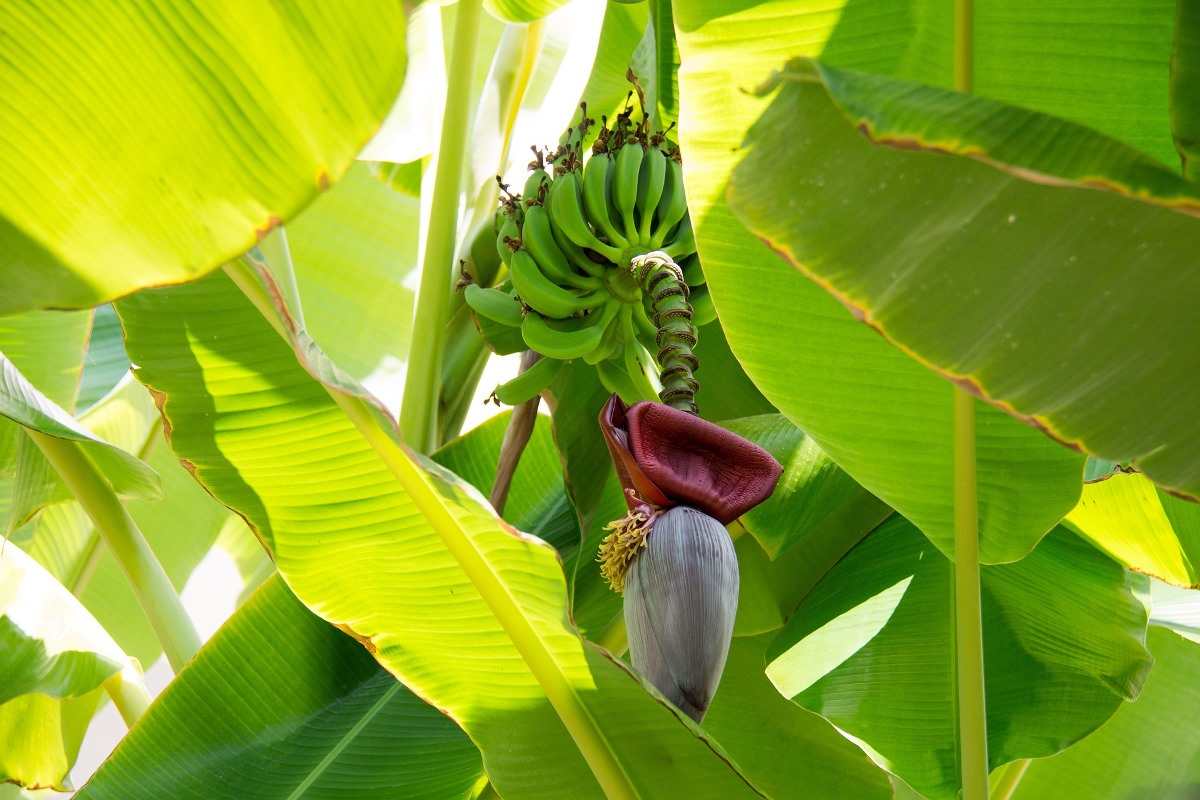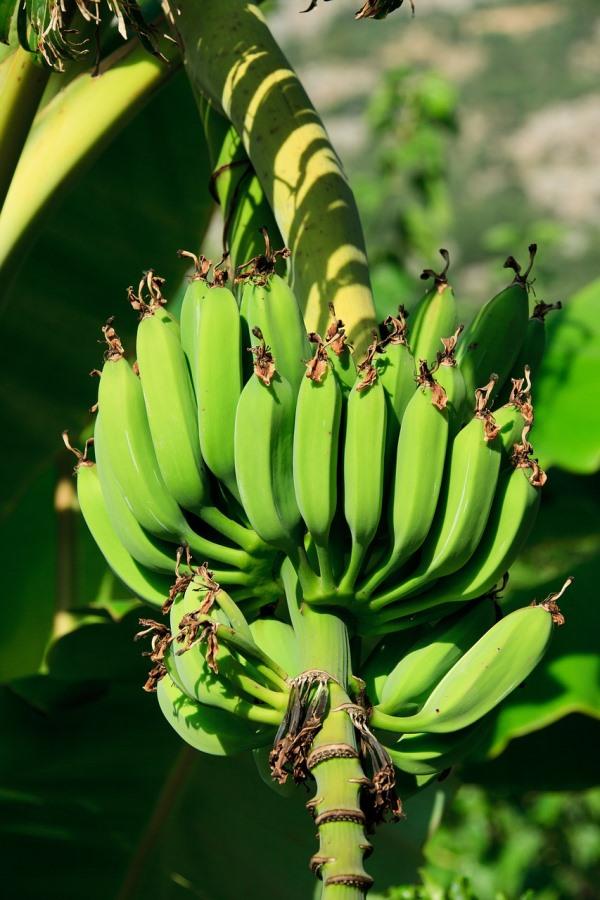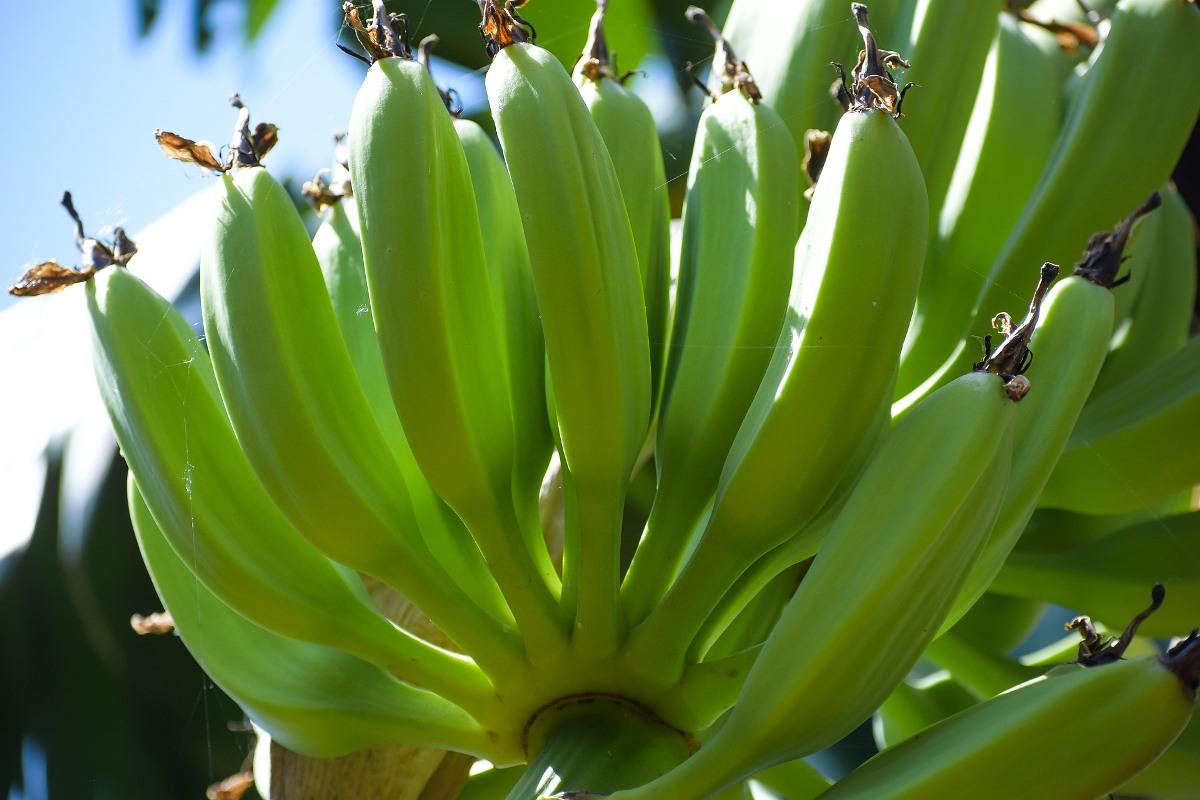Growing Banana Plants in Backyard
Hello gardeners, today we are going to discuss growing banana plants in backyard at home. Do you want to know how to grow banana plants? Well, and then follow this complete article to know about growing banana plants at home. In this article, we also cover all the requirements for growing banana plants.
Introduction to Growing Banana Plants in Backyard
A banana is a very elongated and edible fruit – botanically it is called a berry – produced by several kinds of large herbaceous flowering plants in the genus called Musa. In some other countries, bananas are usually used for cooking and they may be even called “plantains”, distinguishing them from dessert bananas. The banana fruit is available in a different size, color, and even firmness, but it is usually elongated and curved, with very soft flesh rich in starch covered with a rind, which may be green, yellow, red, purple, or even brown when ripe.
A Step By Step Guide for Growing Banana Plants in Backyard

Having access to delicious and very healthy bananas will be wonderful if you are prepared for an extended growing period of the plant. If you live in a very warm climate or have a good indoor growing location, read on to learn about the yearlong journey of a healthy banana plant in the backyard.
Suitable Soil for Growing Banana Plants in Backyard
Mostly banana plants love to grow in loose and rich soil. Leave several centimeters that mean a few inches of space at the top to encourage drainage.
You should not use potting soil or your regular garden soil unless you are sure that it is suitable. Soil mixes intended for cacti will produce very good results or ask other growers of the same banana variety.
The ideal and best soil acidity for bananas is between pH 5.5 and 7. Acidity pH 7.5 or higher than that can kill the plant.
Suitable Temperature and Humidity for Growing Banana Plants in Backyard
First, look up your area’s temperature and humidity. Humidity needs to be at least 50% and as constant as possible. Ideal daytime temperatures should be between 26–30ºC, with night temperatures no lower than 20ºC. Suitable temperatures are very warm and very rarely reach lower than 14ºC or higher than 34ºC.
The banana plant will easily take up to a year to produce fruit, so it is important to know what range of temperatures it will experience throughout the complete year.
If the temperature of the area falls below 14ºC, then your banana plants will simply stop growing.
Sunlight Requirement for Growing Banana Plants in Backyard
Find the best sunniest area in your yard. Banana plants grow well and best with 12 hours of direct and bright sunlight each day. They can still grow with fewer means more slowly, but you should determine where in your backyard receives the most sun.
Select an Area with a Good Drainage System for Growing Banana Plants in Backyard
Choose an area with very good drainage. Banana plants require a lot of water but are easily prone to rotting if the water does not drain adequately.
To test drainage, you need to dig a hole 0.3m or 1 ft. deep, fill it with water, and then allow it to drain. Refill once it is empty, and then measure how much water is left nearly after 1 hour. Nearly about 7-15 cm water drainage per hour is very good and ideal for banana plants.
A raised garden bed or by adding 20% perlite to the soil assists the drainage system.
This is especially very important if you are using a banana plant that does not yet have leaves, or even had the leaves removed for shipping. Leaves will help evaporate excess water.
Allow Sufficient Space for Growing Banana Plants in Backyard
While banana plants are technically called herbs, they are usually mistaken for trees for another reason. Some other varieties and individuals can easily reach up to 7.6 m or 25ft. in height.
Each banana plant requires at least a hole of 30cm or 1ft. wide and 30cm or 1ft. deep. Very large holes should be used in areas of high wind (but it will require more soil).
You need to keep banana plants at least 4.5 meters or 15 feet from trees and shrubs (no other banana plants) with very large root systems that may compete with the banana plants’ water.
Multiple banana plants can help each other maintain beneficial humidity and even temperature levels, as long as they are planted at the correct or appropriate distance. Dwarf varieties will require very little space.
Selection of planting material for Growing Banana Plants in Backyard
You need to select your planting material. You will acquire a banana sucker that means a very small shoot from the bottom of a banana plant from another grower or plant nursery, or buy one online. A banana rhizome is that the base from which suckers grow easily. Tissue cultures are produced in laboratories to make higher fruit yield. If you’re transplanting a mature plant, prepare a hole appropriate to its size and have an assistant assist you.
The best suckers to use are 1.8-2.1m or 6–7ft tall and have thin, sword-shaped leaves, although smaller suckers should work well if the mother plant is healthy. Big, round leaves are a symbol that the sucker is trying to form up for a scarcity of adequate nutrition from the mother plant.
If the sucker remains attached to a mother plant, then you need to remove it by cutting forcefully downward with a clean shovel. Include a big portion of the underground base (corm) and its attached roots.
A rhizome (corm) without notable suckers is often chopped into pieces. Each bit with a bud means proto-sucker will grow into a separate banana plant, but this may take longer than employing a sucker.
Place the plant upright within the new soil. The leaves should be pointing upward and therefore the soil should cover the roots and 1.5–2.5cm or 0.5–1 inches of the bottom. Tamp the soil right down to keep it in situ but don’t pack too firmly
How to Trim/Prune Banana Plant?
Trim the banana plant. Cut off all dead, insect-eaten, rotting, or even discolored sections of the banana plant. If most of the plant is affected, you need to dispose of it away from other plants and better find another planting material.
If using a sucker, you need to remove all but a few centimeters or 1–2 inches of the roots. This can easily limit the chance of disease. You can even remove any leaves over five or you can cut the top of the banana plant off with a slanting cut to increase the amount of sunlight that warms the soil for root growth and even rot prevention.
Water Requirement for Growing Banana Plants in Backyard
Water frequently and it is better to avoid overwatering. Under watering is a common reason for banana plant death, but overwatering can easily cause the roots to rot.
In very warm growing weather without rain, you will need to water your plant daily, but only if the top 1.5–3 cm or 0.5–1 in. of soil is dry. You need to test with your finger before watering.
You need to reduce the amount of water per session if the plant is sitting in water for long periods. In very cooler temperatures when the banana is barely growing, you will only need to water once every week or two. Always remember to check soil moisture.
Leaves will help easily evaporate excess moisture, so you need to be careful not to soak but just moisten a young plant that has not yet grown leaves.
Better water the ring of fertilizer as well to help it soak into the soil.
Providing Support for Banana Plants in Backyard
Support the banana plant to avoid toppling of the banana plant due to very strong wind or even bunch weight. There are 3 easy ways of doing it. They are listed below:
Wire or Rope and Bottle Method: you need to cut off the bottom of a plastic bottle. Better insert a very long wire or very strong twine through the mouth and bottom of the bottle. Crunch the bottle to form it bendable and soft. Prop the banana stem on the bottle, and use the wire to tug the stem slightly more upright. Tie the write to strong support.
Single Bamboo Method: Use a 3m or 10inch long bamboo pole or other strong, durable material. Cut a bit of Y-shaped wood 10cm or 4inches thick and 60cm or 2inch wide. Let the stem rest on the center of the “Y” and push the bamboo upwards a touch bit therefore the stem is wedged into the “Y” tightly. Bury the opposite end of the bamboo (the base) deeply into the bottom. Tamp very firmly.
Double Bamboo Method: Use two 3m or 10inch long bamboo poles. On one end of the poles, tie them alongside a robust wire 30 cm or 1inch from the top. Open up the poles to make a letter “X”. Let the stem rest on the short end, push upwards a touch bit to make pressure, and bury the opposite ends of both poles. Tamp very firmly.
How to Fertilize Banana Plant Growing in Backyard?
Fertilize every month with a short distance from the trunk. Use store-bought fertilizer, compost, manure, or a mix of those. You need to add fertilizer immediately after planting in a good ring around the banana plant and then repeat at monthly intervals.
Young plants require 0.1–0.2kg or 0.25–0.5lbs monthly, rising to 0.7–0.9kg or 1.5–2 lbs. for an adult plant. Increase gradually as your plant grows.
If the temperature of the area falls below 14ºC or if the banana plant has not grown since last month, then better to skip the fertilization to the plant.
Fertilizers are usually labeled with three numbers (N-P-K) representing the quantity of Nitrogen, Phosphorus (Potash), and Potassium. Bananas require very high amounts of Potassium, but the opposite nutrients are important also. You’ll use a balanced fertilizer (three numbers roughly equal) or a fertilizer that addresses deficiencies in your soil.
Do not use manure produced within a previous couple of weeks, because the heat it releases while decomposing can damage the plant.
Caring Tips for Growing Banana Plants in Backyard

You need to add mulch. Remove all the dead leaves and banana plants and then chop them up to place around the live plants. Other backyard waste and even wood ash can also be added to return nutrients to the soil.
Check the mulch regularly and then remove any weeds that are growing. These will compete with the banana plant.
De-sucker your banana plants. Once your banana plant is enough mature and then has several suckers, then better to remove all but one to improve fruit yield and plant health. The surviving sucker is then known as the follower and then will replace the mother plant after it dies.
Exceptionally very healthy plants can support two followers.
Winter Care for Banana Plants Growing In Backyard
- How to Grow Hibiscus from Flower
- Plantation Ideas for Home Decoration: A Beginners Guide
- Flower Garden Designs and Layouts for Beginners
- Planting and Spacing Techniques in Papaya: A Beginner’s Guide
- Growing Gold: Essential Techniques for Planting Pineapples
- How to Make Kalanchoe Plant Bushy: Home Remedies and Solutions
- 11 Reasons Why Your Gardenia is Not Blooming: Home Remedies and Solutions
- Eco Elegance: The Guide to Designing a Drought-Tolerant Landscape
- Gardening on a Slope: Strategies for Hillside Landscaping
- Nourish and Flourish: Top Organic Mulches for Thriving House Plants
- Everything You Want to Know about Indian Mogra Flower: Discover Uses and Growing
- Green Thumb Success: Expert Tips for Cultivating Greenhouse Pumpkins All Year Round

Provide overwinter care. If the temperature during the winter months falls too low for your plant, there are several ways to worry about it:
Cover the stem with a blanket or soil. If there’s no frost and therefore the plant remains small, this might be adequate protection until the temperature rises high enough for it to grow again.
Store the plant inside. Uprooting the whole plant, removing the leaves, and store in moist sand during a heated indoor area. Don’t water or fertilize; the plant will go dormant until you’re able to plant it outside again.
Grow the plant inside. This may require an outsized pot with a drainage hole. If you do not want to grow your banana too big for your pot, you’ll get to cease or reduce the fertilizer treatments.
Salvage pieces to plant later. If frost or cold has killed most of your plant, the likelihood is that the suckers and corm at the bottom are still usable. Cut these far away from the dead portion and store them in their small pots to plant outside later.
Common Problems in Growing Banana Plants in Backyard
Keep an eye out for discolorations, dying leaves, and even pests. If diseased plants are discovered, then identify and treat them immediately, or uproot them. Insect pests will also be controlled as soon as they are found. Nitrogen and even potassium deficiencies are the two most common nutritional problems for banana plants, so learn to recognize those signs.
Signs of nitrogen (N) deficiency are observed as very small or pale green leaves and reddish-pink leaf sheaths; poor growth rate and even very small fruit bunches.
Signs of potassium (K) deficiency are observed as the rapid appearance of orange or yellow color on leaves followed by leaf death and very small or broken leaves; delayed flowering; very small fruit bunches.
Examples of major plant diseases include
- Bacterial wilt
- Moko disease
- Panama disease
- Fusarium wilt
- Banana bunchy top
- Blackhead
- Root rot
- Toppling disease
- Black leaf streak
Examples of major plant pests include
- Corn weevil
- Banana Aphid
- Mealy Bugs
Fruit pests include
- Flower Thrips
- Red Rust Thrips
- Scarring Weevil
Nurturing and Harvesting Banana Fruits
You need to wait for the petals to withdraw and reveal bananas. This might take a further 2 months or longer. Each connected cluster of bananas is named a “hand” and every banana, a “finger”. The whole stem containing several hands is named a bunch.
Once all bunches are revealed, remove the additional portions. The remaining bud or very tiny extra banana hand are the sterile male portions of the banana plant. The hand should wither off on its own, but removing the bud will cause the plant to place more energy into growing fruit.
The male portion of the flower is named the “banana heart”. Some sorts of banana plants produce Musa paradisiaca sapientum flowers that are popular in Southeast Asian cuisine, but not all are suitable for consumption. Most of the flowers will fall off and then die before harvest.
Use a stick to prop the plant if the bunches are dragging it down.
Cover the bunch with plastic covers. This may protect the fruit from insects and other dangers, but they need to be open at both ends to permit adequate air and water flow.
Tie the nylon or plastic sack with soft twine several inches from the primary hand.
Harvest bananas when the flowers or plants are dying. The tiny flower at the tip of every banana will become dry and simply abrade, or the banana plant will lose most of its leaves. This is often an honest time to reap the fruit.
You need to cut one notch halfway into the tree, and opposite the side of the bunch.
Carefully let the tree bend and stop the bunch.
The fruit will ripen quickly once harvested, so you’ll want to select some well beforehand of harvesting so you do not find yourself with excess fruit which will attend waste.
In case if you miss this: Growing Organic Lettuce.